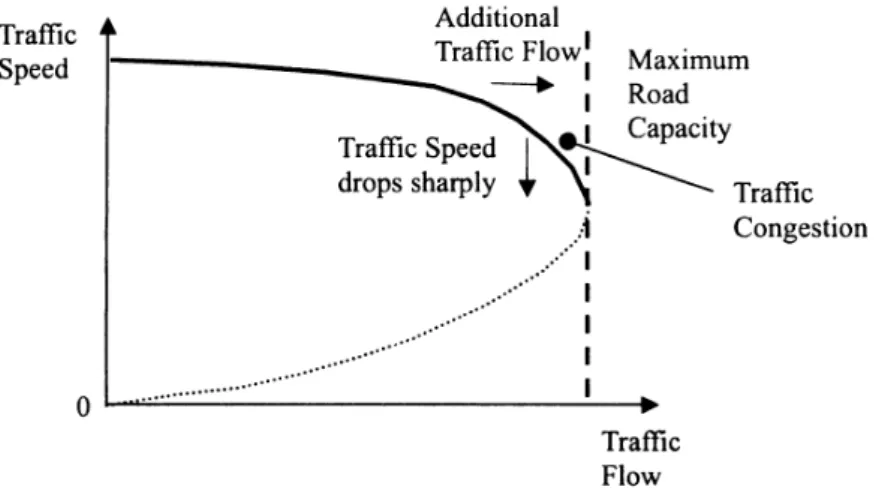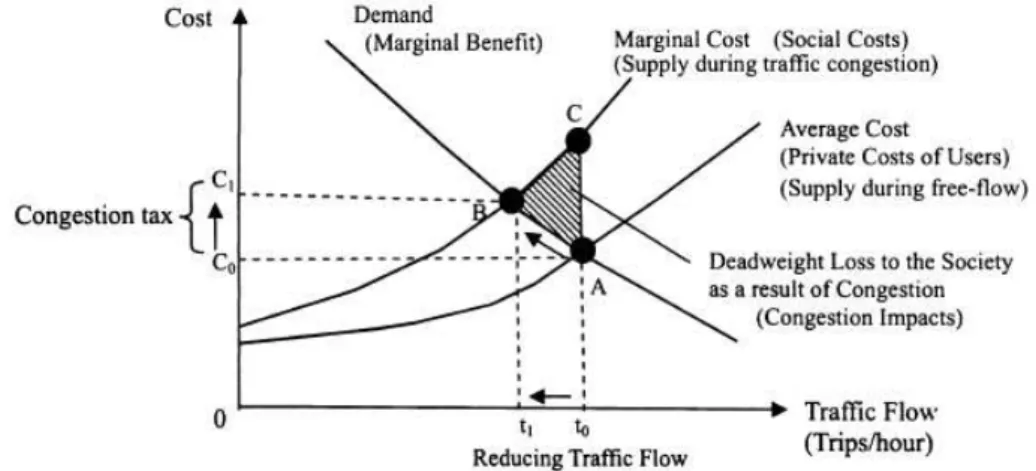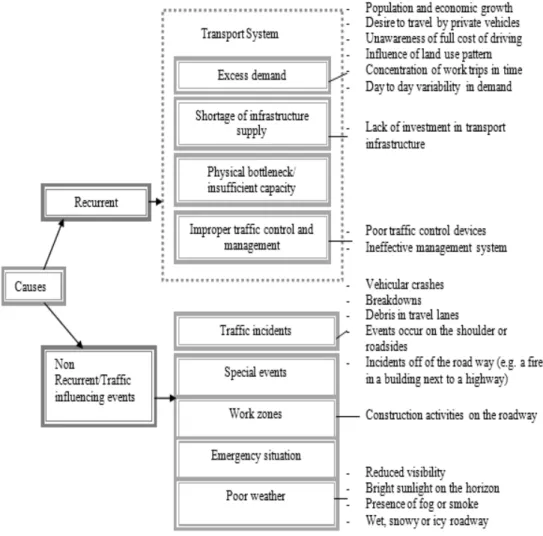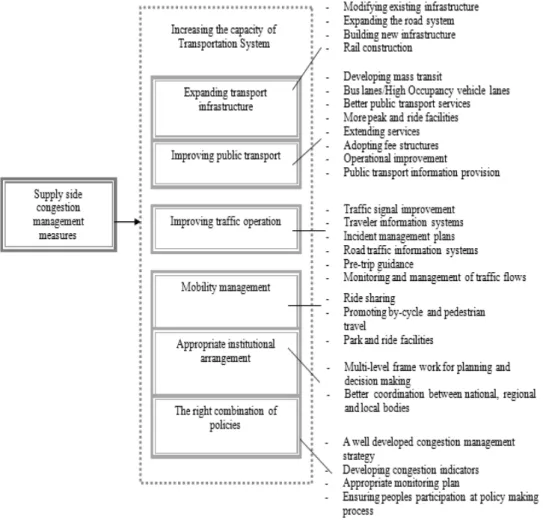Framework for Traffic Congestion Management
Mahmud Hassan TALUKDAR1
ABSTRACT
Traffic Congestion is one of many serious global problems in all great cities resulted from rapid urbanization which always exert negative externalities upon society. The solution of traffic congestion is highly geocentric and due to its heterogeneous nature, curbing congestion is one of the hard tasks for transport planners. It is not possible to suggest unique traffic congestion management framework which could be absolutely applied for every great cities. Conversely, it is quite feasible to develop a framework which could be used with or without minor adjustment to deal with congestion problem. So, the main aim of this paper is to prepare a traffic congestion mitigation framework which will be useful for urban planners, transport planners, civil engineers, transport policy makers, congestion management researchers who are directly or indirectly involved or willing to involve in the task of traffic congestion management. Literature review is the main source of information of this study. In this paper, firstly, traffic congestion is defined on the theoretical point of view and then the causes of traffic congestion are briefly described. After describing the causes, common management measures, using world- wide, are described and framework for supply side and demand side congestion management measures are prepared.
KEYWORDS: Framework, traffic congestion, causes, management measures
JEL CLASSIFICATION: O18, R41
1. DEFINITION OF TRAFFIC CONGESTION
As European Conference of Ministers of Transport (ECMT) (2007) stated, traffic congestion can be interpreted in different ways and there is no single definition for it. Congestion is a situation in which demand for road space exceeds supply. It is the impedance vehicles impose on each other, due to the speed-flow relationship, in conditions where the use of a transport system approaches capacity. Congestion arises when traffic is delayed because of the presence of other vehicles (Link et al. 1999, p. 9). Congestion usually relates to an excess of vehicles on a portion of roadway at a particular time resulting in speeds that are slower—sometimes much slower—than normal or "free flow" speeds (Department of transportation, U.S., 2005, p. 1). Congestion is essentially a relative phenomenon that is linked to the difference between the roadway system performance that users expect and how the system actually performs. European Conference of Ministers of Transport (ECMT) (1999) stated, Traffic congestion is long queues of vehicles which are constantly stopping and starting. Travelers even cannot move in a desirable manner under serious conditions (Levinson et at., 1997). Traffic congestion is defined as a condition of traffic delay (i.e., when traffic flow is slowed below reasonable speeds) because the number
of vehicles trying to use a road exceeds the design capacity of the traffic network to handle it (Weisbrod, Vary, et al. 2003, p. 1). According to the engineering theory of traffic congestion, the natural explanation of congestion is a lack of road capacity, that is, a shortage of supply (Thomson, 1998, p. 94). So, traffic congestion can be defined by two ways; one is high vehicle concentration and low flow speed and another one is approaching the maximum capacity of the road. Congestion is an imbalance of travel demand and transport system supply (Hon, 2005, p. 24).
As reflected by figure 1, traffic speed will be sharply slowed down when traffic flow is added to reach the capacity. It clearly illustrates what happen in the traffic congestion and how closely is it related with the road capacity.
From the economic point of view traffic congestion is defined differently. In views of economists, traffic congestion is a classical example of the overuse of a common resource (Blow et al., 2003, p. 2). So, traffic congestion occurs from the overuse of roads. Road users, who ignore their impacts imposed on other users (i.e. increasing marginal social cost), tend to overuse the road inefficiently as their perceived private cost is less than the trip benefit (Hon, 2005, p. 14).
Figure 1 Speed-flow relationship and traffic congestion Source: ECMT, 1999; Hon, 2005, p. 14
Figure 2. Traffic congestion as an externality Source: Blow, Leicester and Smith (2003, p. 2); Hon (2005, p. 15)
2. CAUSES OF TRAFFIC CONGESTION
According to the European Conference of Ministers of Transport (ECMT) (2007), causes of congestion are numerous such as; too many vehicles, land use patterns, employment patterns, income levels, car ownership trend, infrastructure investment, regional economic dynamics etc and casual factors of congestion can be categorized into two ways; micro and macro or recurrent and non recurrent. Micro-level factors are those that relate to ―traffic on
the road‖ and macro-level factors that relate to ―overall demand for road use‖ (ECMT, 2007, p. 14). Recurrent factors occur when ―demand approaches the technical maximum
throughput capacity on a link or in the network‖ and non recurrent factors are ―unexpected,
unplanned or large events (e.g. road works, crashes, special events and so on)‖ and ―cannot
be easily predicted‖ (ECMT, 2007, p. 15). According to the engineering theory of traffic congestion, congestion could be caused by obstruction, or inefficient use of the roads (Thomson, 1998, p. 94). Hon (2005, p. 19) identified some causes of traffic congestion and presented in graphical form. According to him, causes can be categorized into two types; recurrent and non-recurrent. Recurrent includes excess demand for travel and shortage of infrastructure supply whereas non-recurrent causes include unexpected events such as; accidents or other emergency events. He further identified some causes which exhilarates the demand which are; population and economic growth, desire to travel by private vehicle, unawareness of full costs of driving, influence of land use pattern and concentration of work trips in time. Lack of investment in transport infrastructure and reduction of road space due to road construction and maintenance are two other identified factors which are leading the shortage of infrastructure supply. He further mentioned that improper traffic controls and management represents intervention failure is one of the causes of traffic congestion.
example of traffic incidents. Construction activities on the roadway is the example of work zone and reduced visibility, bright sunlight on the horizon, presence of fog or smoke, wet, snowy or icy road way are the example of poor weather. Traffic demand includes; fluctuations in normal traffic such as day to day variability in demand and special events such as cricket tournament may increase the congestion at the surrounding streets of the stadium. Physical highway features includes; poor traffic control devices and physical
bottlenecks (―capacity‖) of the road.
Figure 3. Causes of traffic congestion Source: Prepared by the author through literature review
3. COMMON MANAGEMENT MEASURES FOR RELIEVING CONGESTION
There is no absolute solution to fully eradicate traffic congestion problem from the society as it is fully related with individual land use pattern and existing transport policies to each
urban region. Congestion coexisted with the economic activity and hence ‗fully eradicating
urban areas (ECMT, 2007, p. 20). So, the goal is to effectively minimize congestion and its effects through appropriate mitigation measures which ‗requires both a holistic and integrated strategy that goes beyond the visible incidence of congestion on the road and extends to the management of the urban region as a whole‘ (ECMT, 2007, p. 20). Realizing this fact, European Conference of Ministers of Transport, ECMT (2007, p.20) suggests three strategic congestion management principles; firstly, ensure that land use planning, and the community objectives it embodies, is coordinated with congestion management policies; secondly, deliver predictable travel times and thirdly, manage highly trafficked roadways to preserve adequate system performance. However, many literatures (e.g. Downs, 1992; OECD, 1994; Strickland et al., 1995; Ramón, 2000 & Hon, 2005, p. 24) have systematically classified congestion management measures into two groups, namely supply-side measures and demand-side measures. On the basis of this classification, common management measures for relieving congestion are described underneath.
3.1 Supply-side Management Measures
Engineering theory of traffic congestion concentrated on increasing the traffic capacity of road links, junctions, and whole urban networks by restrictions on parking, pedestrians, access, and even public transport, as well as new road construction (Thomson, 1998, p. 94). European Conference of Ministers of Transport, ECMT (2007, pp. 25-29), proposes some supply side congestion management measures which are; improving traffic operations, improving public transport, implementing mobility management, modifying existing infrastructure etc. However, the common supply side congestion management measures are mentioned in figure-4.
Expanding transport infrastructure
Figure 4. Framework for supply side congestion management measure Source: Prepared by the author through literature review
Improving public transport
Improving public transport is an important supply management strategy of the transport
system for congestion mitigation as it ‗can transport more people than individual cars for a
Improving traffic operation
According to, European Conference of Ministers of Transport, ECMT (2007, p. 21), Typical congestion mitigation measures include planning and coordination of road-works, speedy response to defective traffic signals and to disruptions caused by accidents and debris. These approaches can be very attractive as they can rapidly deliver perceivable benefits to road users for a relatively small investment – especially when compared to the cost of new infrastructure whose impacts on overall travel times may not always be perceived by road users. Efficient and coordinated traffic control systems, can timely adjust the road capacity to accommodate additional traffic and reduce unnecessary travel delays (Hon, 2005, p. 27). Improving traffic operation typically consists of use of traffic signals, implementation of contingency plans, provision of real time traffic information, pre-trip guidance, monitoring and management of traffic flows (Judycki et al., 1992; Black, 2003; Hon, 2005; ECMT, 2007).
Mobility Management
.
There are numerous mobility management strategies that can, when successful, reduce car use in urban areas. These include ride-sharing, promoting bicycling and pedestrian travel or supporting mobility management efforts targeting large trip generators such as companies (ECMT, 2007, p. 26)
Appropriate institutional arrangement
Appropriate institutional arrangement is essential for the effective traffic congestion management. Appropriate institutional arrangement can be provided through an integrated multi-level approach and therefore a multi-level framework of planning and decision making is required. Moreover, tackling congestion requires a plan that encompasses the
complexities of the congestion problem and addresses the spatial extent of the region‘s
travel patterns and the relevant institutional and private actors across the urban area (ECMT, 2007, p. 28). According to European Conference of Ministers of Transport, ECMT (2007, p. 28), There is no single approach best-suited to addressing congestion. But when the scope of institutional decision-making is well-matched to the region‘s travel to work area, vision or plan-led approaches work well. Conversely, when there is a mis-match
between the scope of jurisdictions‘ reach, powers and funding and the geographical scale of
the problem, consensus-based approaches make better sense. Consensus-based approaches may also make sense when there is a mis-match between decision-making authority and availability and/or conditioning of external funds. Implementing a congestion management strategy requires the collaboration of many different actors. Achieving consensus, commitment and public support for the formulation of the strategy requires even wider. Wide participation can ensure that the full range of objectives is considered. It can provide a better understanding of transport problems, help generate innovative solutions and be a key factor in gaining public support and acceptability for the final mix of policies.
The right combination of policies
3.2 Demand-side Management Measures
Demand-side congestion management measures are also important for relieving congestion problem as it reduces the demand for vehicle use. ECMT (2007, pp. 21-23), suggested three related demand side management approach; access management, parking management and pricing policies. ECMT (2007, p. 20) also suggested to Ensure that land use planning, and the community objectives it embodies, is coordinated with congestion management policies. Access management and parking management are regulatory measures and pricing policies are economic measures. So, ECMT actually describes three aspects of demand side congestion management; economic, regulatory and land-use. These three aspects are also described by Hon (2005, p. 28) as effective demand side congestion mitigation measures. However, figure-5 summarizes demand side congestion mitigation measures.
Economic measures
Economic measures are important demand side management measures which can alter human behaviors to avoid congestion. Various economic measures are found through literature search such as; taxation (Disincentives), subsidies (Incentives), mixed use tool roads, cordon charges, road tolls, congestion pricing/ Tax, area licensing scheme, electronic road pricing, cordon charges, linked based pricing system etc.
To restrain traffic growth, taxation measures, known as financial disincentives, are used. These taxes are often imposed on vehicle ownership, including car purchase tax and annual registration tax, and on vehicle use, such as taxes on fuel and parking fees (Potter et al., 2003). Imposing such taxes not only raise government revenue, but it also discourages travelers not to use their vehicle (Hon, 2005, p. 29). On the other hand, to assort with taxation, subsidies, known as financial incentives, are also used. These subsidies are often payments made for financing public transport operation and developing environmental friendly transport modes, such as cycling (Button, 1992). Other policies include cordon charges such as those implemented in Singapore, London and Stockholm, link-based pricing systems such as have been put in place on certain urban toll-ways, and mixed-use toll roads (e.g. HOT Lanes in the United States). All have proven to be effective measures to reduce congestion and manage traffic. (ECMT, 2007, p. 23)
Taxation and congestion pricing is opposed by the public because it is viewed as an additional tax and no one wants to be charged for something that was free before. Facing such oppositions, many cities regard congestion pricing as a last resort even though it is effective for reducing congestion problems (Hon, 2005, p. 32). In the case of link-based pricing, there is a risk that pricing policies will transfer traffic flows onto free roads and so create new congestion in other areas. It is therefore important to plan complementary measures such as the modification of road infrastructure and traffic operations management. Parallel measures such as investments in public transport can also be employed to make pricing more acceptable and also fairer for people who cannot afford the charges or tolls and thus contribute to acceptability (ECMT, 2007, pp. 23-24).
Regulatory measures
Regulatory measures refer to administrative measures, policies, regulations or even
legislations that directly alter the travelers‘ behaviors (Hon, 2005, p. 33). Regulatory measures include; access management, parking control, restrictions on vehicle use, traffic calming and flexible working hours. Regulatory measures have many constraints. First, to the public, these measures, especially the restrictions on automobile use, narrow down individual choices and are too rigid to human freedom. These may not be applicable to every community. Secondly, these measures often adversely affect economic well-beings by altering normal traffic flows (Hon, 2005, pp. 34-35).
Land use policies
Transport and land use policies are closely related. Land uses gives rise to trip generation and influence regional trip patterns. So, it is necessary to co-ordinate long term land use and transport planning. Experience from a number of countries and regions has shown that strongly coordinated transport and land use policies allows to proactively and beneficially manage the scope and nature of urban travel demand and thus reduce the incidence and severity of congestion (ECMT, 2007, p. 20). To address congestion problem in the long run, land use policies for adjusting that imbalance are necessary. Through planning, land uses should be re-located in such a way that the need and the amount to travel can be minimized. With optimal land use and development policies, the demand for travel can be reduced to the least level (Hon, 2005, p. 35).
REFERENCES
Black, W.A. (2003). Transportation: a Geographical Analysis, New York: Guilford Press.
Blow, L., Leicester, A. & Smith, Z. (2003). London‘s Congestion Charge, The Institute for Fiscal Studies Briefing Note, 31, 1-18.
Button, K. (1992). Market and Government Failures: in Environmental Management: the Case of Transport, Paris: Organization for Economic Co-operation and Development. Department of transportation, U.S. (2005). Traffic congestion and reliability: Trends and
advanced strategies for congestion mitigation, Office of Operations, Texas Transportation Institute, Federal Highway Administration.
Downs, A. (1992). Stuck in Traffic: Coping with Peak-Hour Traffic Congestion, Washington, D.C.; Cambridge, Massachusetts: The Brookings Institution; the Lincoln Institute of Land Policy.
European Conference of Ministers of Transport, ECMT (1999). Report of the Hundred and Tenth Round Table on Transport Economics held in Paris on 12 -13” March 1998 on The following topic: Traffic Congestion in Europe, Paris: Economic Research Centre, European Conference of Ministers of Transport.
European Conference of Ministers of Transport, ECMT (2007). Managing urban traffic congestion- summary document, Transport Research Centre, European Conference of Ministers of Transport.
Hon, M. L. (2005). Evaluation of traffic congestion relieving options with using cost-benefit analysis: case study of Central-Wan Chai, unpublished MSc. Thesis, The University of Hong Kong.
Judycki, D.C. & Berman, W. (1992). Transportation System Management. In: John, D.E., Jr., P.E. (ed.), Transportation Planning Handbook, Englewood Cliffs, New Jersey: Prentice-Hall.
Levinson, H.S., Lomax, T.J. & Turner, S. (1997). Traffic Congestion - Past - Present- Future. In: Rahim, F. (Ray) Benekohal(ed.), Traffic Congestion and Traffic Safety in the 21st Century: Challenges, Innovations, and Opportunities: Proceedings of the Conference, Chicago, Illinois, June8-11, 1997, New York: American Society of Civil Engineers.
Link, H., Dodgson, J.S., Maibach, M. & Herry, M. (1999). The Costs of Road Infrastructure and Congestion in Europe, Heidelberg: Physica-Verlag.
Potter, S., Enoch, M. & Rye, T. (2003). Economic Instruments and Traffic Restraint. In: Julian, H. and John, P. (eds.), Integrated Futures and Transport Choices: UK Transport Policy beyond the 1998 White Paper and Transport Acts, Aldershot, Hants; Burlington, V.T.: Ashgate.
Ramón, J.G. (2000). The Management of Traffic Demand, Barcelona: Municipal Traffic Department, Barcelona of Spain.
Richards, B. (1990). Transport in Cities, London: Architecture Design and Technology Press.
Strickland, SXI & Berman, W. (1995). Congestion Control and Demand Management, United States Department of Transportation - Federal Highway Administration, 58 (3)
Thomson, J. M. (1998). Reflections on the economics of traffic congestion. Journal of transport economics and policy, 93-112.




